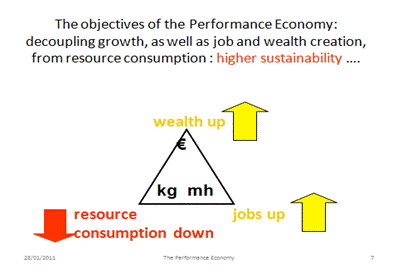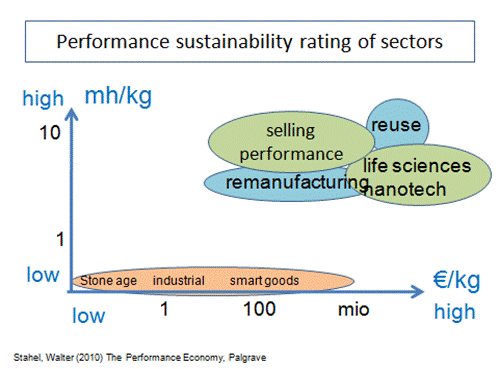‘The Performance Economy’ bridges the gap between the 2010 Lisbon Objectives of the European Union - higher growth and more jobs - and the sustainability objective to greatly reduce the resource con¬sumption - energy and materials - especially of industrialised countries:
ANNOUNCING A NEW BOOK ON SUSTAINABLE ECONOMICS: Stahel, Walter (2010) The Performance Economy, Second Edition, Palgrave-MacMillan, London, 350 pages,
ISBN 978-0-230-58466-2 (first edition 2006)
“More from less”. The books shows how, by thinking ‘smart’, companies and governments can economically profit from technological progress and at the same time contribute to sustainable development. Replete with both successful and failed examples, this useful tool for tomorrow’s functional service economy
- introduces the business models that turn knowledge into better performance, more jobs and greater wealth,
- describes how to improve the manufacturing process, product service sales and performance over time,
- shows how innovations in traditional sectors can preserve embodied resources and create both manual and skilled jobs, resulting in lower unemployment, lower energy consumption, less waste and greatly reduced resource throughput – major ingredients for economic growth.
- Introduces new decoupling metrics to measure the relation between value, jobs and resource consumption.

Chapter 1: Producing Performance
Introduces the new metric of the value-per-weight ratio (€-per-kg) to measure wealth creation in relation to resource consumption and shows strategies how to significantly boost this ratio up to million a Euro per kg resource ratio through, for instance, science and knowledge workers.
Chapter 2: Selling Performance
Presents the business models that enable entrepreneurs to achieve synergies by profitably exploiting the three objectives of more value, more jobs and considerably less resource consumption, and the procurement strategy of buying performance instead of goods. Selling performance has a strong environmental component because it internalises the costs of risk and of waste and rewards sufficiency solutions and systemic solutions.
Chapter 3: Managing Performance over Time
Introduces the new metric of the labour input-per-weight ratio (manhour-per-kg) to measure job creation in relation to resource consumption and highlights ways to radically increase this ratio by preserving value. The business models used focus on extending the service-life of goods, components and infrastructure through reuse, remanufacturing and technological updating. These are the priority strategies put in evidence by the 2008 EU waste directive.
Chapter 4: Sustainability and the Performance Economy
Using the metrics of the Performance Economy, the big difference between the industrial economy and the Performance Economy become apparent, see the figure Performance sustainability rating of sectors.

| Attachment | Size |
|---|---|
| Flyer.pdf | 286.53 KB |
| Mandarin edition of the Performance Economy (scan) | 194.44 KB |
| Book Review by Prof Krishna B Misra, Editor-in-Chief ofIJPE.pdf | 76.15 KB |




